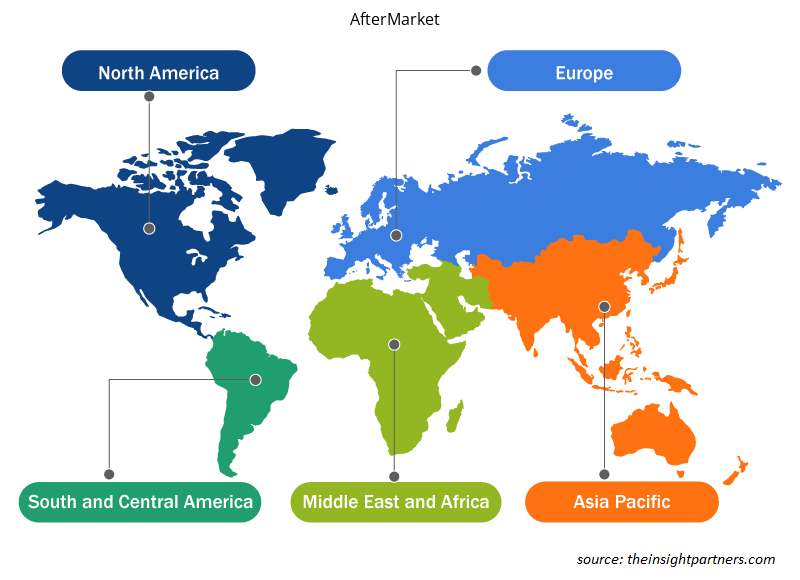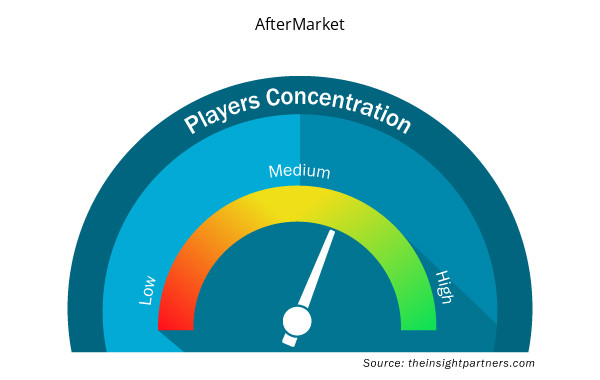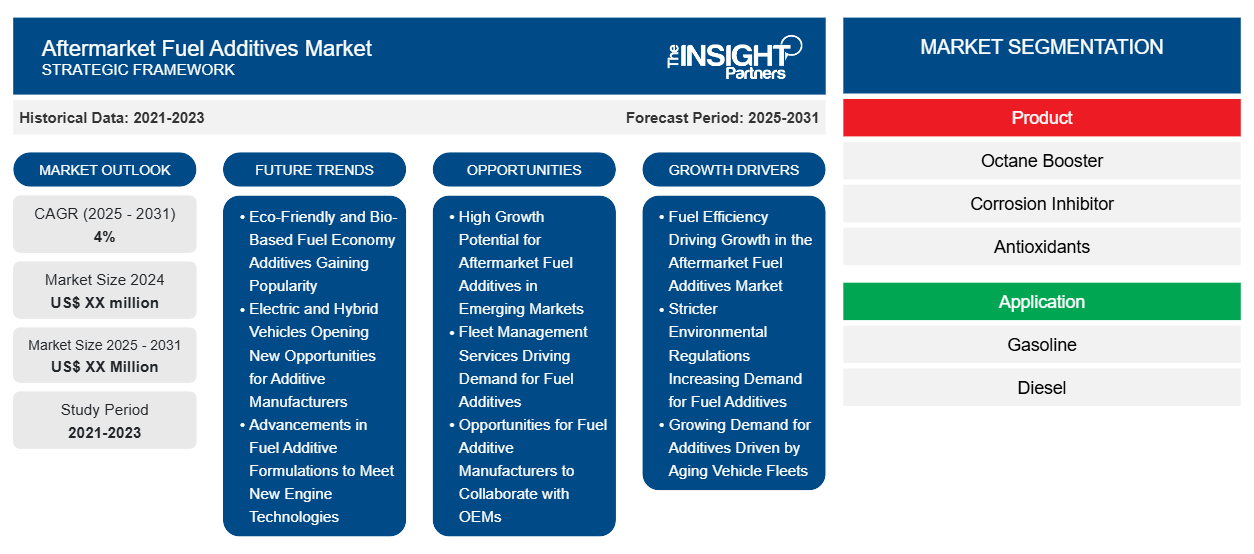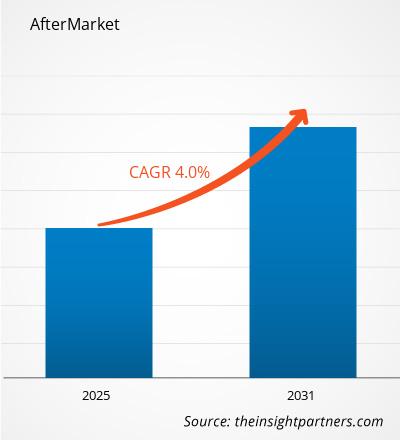The Aftermarket Fuel Additives Market is expected to register a CAGR of 4% from 2024 to 2031, with a market size expanding from US$ XX million in 2024 to US$ XX Million by 2031.
The aftermarket fuel additives market report is segmented by product (octane booster, corrosion inhibitor, antioxidants, and others). The market is segmented based on application (gasoline, diesel, and others). The market is segmented based on end-use industry (automotive, industrial, and others). The market size and forecast at global, regional, and country levels for all the key market segments are covered under the scope. The report offers the value in USD for the above analysis, segments, regions, and countries. The report covers market trends, as well as market dynamics such as drivers, restraints, and key opportunities. The report also covers industry landscape and competition analysis covering market concentration, heat map analysis, prominent players, and recent developments in the market.
Purpose of the Report
The report Aftermarket Fuel Additives Market by The Insight Partners aims to describe the present landscape and future growth, top driving factors, challenges, and opportunities. This will provide insights to various business stakeholders, such as:
- Technology Providers/Manufacturers: To understand the evolving market dynamics and know the potential growth opportunities, enabling them to make informed strategic decisions.
- Investors: To conduct a comprehensive trend analysis regarding the market growth rate, market financial projections, and opportunities that exist across the value chain.
- Regulatory bodies: To regulate policies and police activities in the market with the aim of minimizing abuse, preserving investor trust and confidence, and upholding the integrity and stability of the market.
Aftermarket Fuel Additives Market Segmentation
Product
- Octane Booster
- Corrosion Inhibitor
- Antioxidants
Application
- Gasoline
- Diesel
End-Use Industry
- Automotive
- Industrial
Geography
- North America
- Europe
- Asia-Pacific
- South and Central America
- Middle East and Africa
Customize This Report To Suit Your Requirement
You will get customization on any report - free of charge - including parts of this report, or country-level analysis, Excel Data pack, as well as avail great offers and discounts for start-ups & universities
- Get Top Key Market Trends of this report.This FREE sample will include data analysis, ranging from market trends to estimates and forecasts.
Aftermarket Fuel Additives Market Growth Drivers
- Fuel Efficiency Driving Growth in the Aftermarket Fuel Additives Market: In the aviation industry, the growing focus on fuel efficiency and engine performance has been a main driving factor for the actors in the aftermarket fuel additives market. This is attributed to the rise in fuel prices and the growing concern for better fuel economy. In other words, individuals and businesses are looking for better means to optimize their fuel use by reducing consumption. Aftermarket fuel additives, which include and are not limited to fuel system cleaners, octane boosters, and diesel additives, work to increase combustion efficiency, lower fuel usage, and optimize engine performance. The increasing concerns regarding the need for better fuel economy in personal cars and commercial vehicle fleets are, in turn, creating a market for these additives.
- Stricter Environmental Regulations Increasing Demand for Fuel Additives: Stricter environmental regulations are being enacted across the globe in a bid to lessen vehicular emissions and enhance the state of the atmosphere. These laws expect both automakers and car owners to minimize pollution and optimize fuel use. Fuel system efficiency can be enhanced with fuel additives that enable clean burning of the fuels thus EPA-compliant vehicles. It is also important to note that Emissions standards will be met using additives such as fuel detergents, which are useful in suppressing carbon build-up and ensuring efficient fuel dispersal. The regulation definitional landscape is evolving more rapidly compared to the allowable limits of combustive emissions from aircraft engines, increasing the need for aftermarket fuel additives for the standards.
- Growing Demand for Additives Driven by Aging Vehicle Fleets: As the global fleet of vehicles grows, the demand for restraining and enhancing retro-fitting products is also going up especially for the warm vehicular population. With quite a number of vehicles being sold, vehicle owners and fleet operators are looking for affordable methods of improving the engine's useful life, enhancing burn efficiency, and cutting down expenses on servicing. Engine fuel additives are vital in such engines during their service as they help in cleaning the fuel injectors, help in better combustion, and less the wearing of the engine internals. The pattern trend of aging vehicle fleets, especially in most developing countries, is another major factor contributing to the growth of the demand for aftermarket fuel additives.
Aftermarket Fuel Additives Market Future Trends
- Eco-Friendly and Bio-Based Fuel Economy Additives Gaining Popularity: With the purpose of meeting the Emerging Market demand, fuel economy additives tend to be more eco-friendly or bio-fuel based. Most of the conventional fuel economy additives used in the market are harmful in the context of environmental protection. In such a case, the development of products that can effectively satisfy the need for sustainable solutions was undertaken. The additives that are made from terrestrial plants and other raw natural sources are also becoming more accepted since they render the same performance advantages but have a lower effect on the environment. It is evident that the use of environmentally friendly additives will be the future of the market.
- Electric and Hybrid Vehicles Opening New Opportunities for Additive Manufacturers: The growth of electric and hybrid vehicles comes with a drawback for the conventional fuel additives market; however, it also opens doors for additive manufacturers to think outside the box and make products that are suitable for hybrid engines. This is because hybrid vehicles need some tune-ups on how their hybrid engine systems depend on internal combustion engines and electric motors/generators, fueling further performance. Demand for such progressed systems performance add-ons is expected to increase due to hybrid system development. Reduction of emissions and better fuel burn efficiency will also contribute to the fuel additives market growth. With continued growth in electric and hybrid vehicle sales, the needs of the aftermarket fuel additives market will have to change.
- Advancements in Fuel Additive Formulations to Meet New Engine Technologies: The evolution of advanced fuel additive formulations is propelled by the enhancement of technological capabilities. Next-generation additives have been designed to meet the demands of the new engine systems such as high-pressure fuel injectors and turbocharged as well as hybrid engines. There will be an increasing trend in the market for the development of multiple-purpose additives, which help to stabilize the fuel, improve lubrication, slow down rusting, and clean the fuel system. These formulations are aimed at the changing engine technology performance requirements thus their increasing usage in the aftermarket fuel additives market.
Aftermarket Fuel Additives Market Opportunities
- High Growth Potential for Aftermarket Fuel Additives in Emerging Markets: Aftermarket fuel additives market is witnessing a high growth rate in relatively new regions like Asia-Pacific, Latin America, and Africa. In these regions, factors such as rising disposable incomes, an increase in ownership of vehicles, and a rise in awareness regarding vehicle maintenance are fostering the demand for fuel additives. The growth in vehicle population in these regions presents a major opportunity for manufacturers to explore regions in such countries and introduce regional fuel additives that are specifically designed for these aircraft and their respective engines. This provides a considerable market growth prospect for the aftermarket fuel additives industry at a global level.
- Fleet Management Services Driving Demand for Fuel Additives: The increasing utilization of fleet management services in the logistics as well as transportation industries offers a scope for the growth of the aftermarket fuel additives market. There has been an increased use of fuel additives by fleet operators for better performance and efficiency of their fleets. Fuel additives help serve the purposes of improving fuel efficiency, lowering operating costs, and maximizing the performance of vehicles. With the growth of the logistics and transport sector globally, especially in regions such as North America and Europe, fleet operators will always look for ways to cut costs, including the use of fuel additives, hence the reason for the opportunity for suppliers of fuel additives.
- Opportunities for Fuel Additive Manufacturers to Collaborate with OEMs: There exists an opportunity here for some manufacturers of fuel additives to strategize on the use of additives in the vehicle context and promote its use in the aftermarket by collaborating with OEMs. OEMs have increasingly started to appreciate the idea of promoting the fuel additives use on their vehicles due to performance and environmental compliance standards. Fuel additive companies have an added advantage since the acceptance of their product by the OEMs, most of the time, leads to the recommended fuel additives being used in the vehicle for the specific fuel added. A final point is that OEMs can help with informing consumers about fuel additives, which can also lead to growth in the market.
Aftermarket Fuel Additives Market Regional Insights
The regional trends and factors influencing the Aftermarket Fuel Additives Market throughout the forecast period have been thoroughly explained by the analysts at Insight Partners. This section also discusses Aftermarket Fuel Additives Market segments and geography across North America, Europe, Asia Pacific, Middle East and Africa, and South and Central America.

- Get the Regional Specific Data for Aftermarket Fuel Additives Market
Aftermarket Fuel Additives Market Report Scope
| Report Attribute | Details |
|---|---|
| Market size in 2024 | US$ XX million |
| Market Size by 2031 | US$ XX Million |
| Global CAGR (2025 - 2031) | 4% |
| Historical Data | 2021-2023 |
| Forecast period | 2025-2031 |
| Segments Covered |
By Product
|
| Regions and Countries Covered | North America
|
| Market leaders and key company profiles |
Aftermarket Fuel Additives Market Players Density: Understanding Its Impact on Business Dynamics
The Aftermarket Fuel Additives Market market is growing rapidly, driven by increasing end-user demand due to factors such as evolving consumer preferences, technological advancements, and greater awareness of the product's benefits. As demand rises, businesses are expanding their offerings, innovating to meet consumer needs, and capitalizing on emerging trends, which further fuels market growth.
Market players density refers to the distribution of firms or companies operating within a particular market or industry. It indicates how many competitors (market players) are present in a given market space relative to its size or total market value.
Major Companies operating in the Aftermarket Fuel Additives Market are:
- FAfton Chemical Corporation
- Ashland Inc.
- BASF SE
- BG Products, Inc.
- Chevron Corporation
Disclaimer: The companies listed above are not ranked in any particular order.

- Get the Aftermarket Fuel Additives Market top key players overview
Key Selling Points
- Comprehensive Coverage: The report comprehensively covers the analysis of products, services, types, and end users of the Aftermarket Fuel Additives Market, providing a holistic landscape.
- Expert Analysis: The report is compiled based on the in-depth understanding of industry experts and analysts.
- Up-to-date Information: The report assures business relevance due to its coverage of recent information and data trends.
- Customization Options: This report can be customized to cater to specific client requirements and suit the business strategies aptly.
The research report on the Aftermarket Fuel Additives Market can, therefore, help spearhead the trail of decoding and understanding the industry scenario and growth prospects. Although there can be a few valid concerns, the overall benefits of this report tend to outweigh the disadvantages.
- Historical Analysis (2 Years), Base Year, Forecast (7 Years) with CAGR
- PEST and SWOT Analysis
- Market Size Value / Volume - Global, Regional, Country
- Industry and Competitive Landscape
- Excel Dataset

Report Coverage
Revenue forecast, Company Analysis, Industry landscape, Growth factors, and Trends

Segment Covered
This text is related
to segments covered.

Regional Scope
North America, Europe, Asia Pacific, Middle East & Africa, South & Central America

Country Scope
This text is related
to country scope.
Frequently Asked Questions
Based on geography, Asia Pacific held the largest share of the aftermarket fuel additives market due to the strong growth of the automotive industry in the region.
Shift toward eco-friendly and bio-based additives is expected to be the key market trends.
Based on end-use industry, the automotive segment is expected to witness the fastest growth during the forecast period.
Afton Chemical, The Lubrizol Corporation, BASF SE, Chevron Corporation, Innospec, Evonik, LANXESS, TotalEnergies, CLARIANT, and Cargill Incorporated are the key players operating in the aftermarket fuel additives market.
Rising demand for fuel efficiency and engine performance is driving the market growth.
The Aftermarket Fuel Additives Market is estimated to witness a CAGR of 4% from 2023 to 2031
Trends and growth analysis reports related to Chemicals and Materials : READ MORE..
1. FAfton Chemical Corporation
2. Ashland Inc.
3. BASF SE
4. BG Products, Inc.
5. Chevron Corporation
6. Evonik Industries AG
7. Innospec Specialty Chemicals
8. Lubrizol Corporation
9. Lucas Oil Products Inc.
10. Total S.A.




 Get Free Sample For
Get Free Sample For